1997 CHEVROLET CORVETTE traction control
[x] Cancel search: traction controlPage 194 of 356
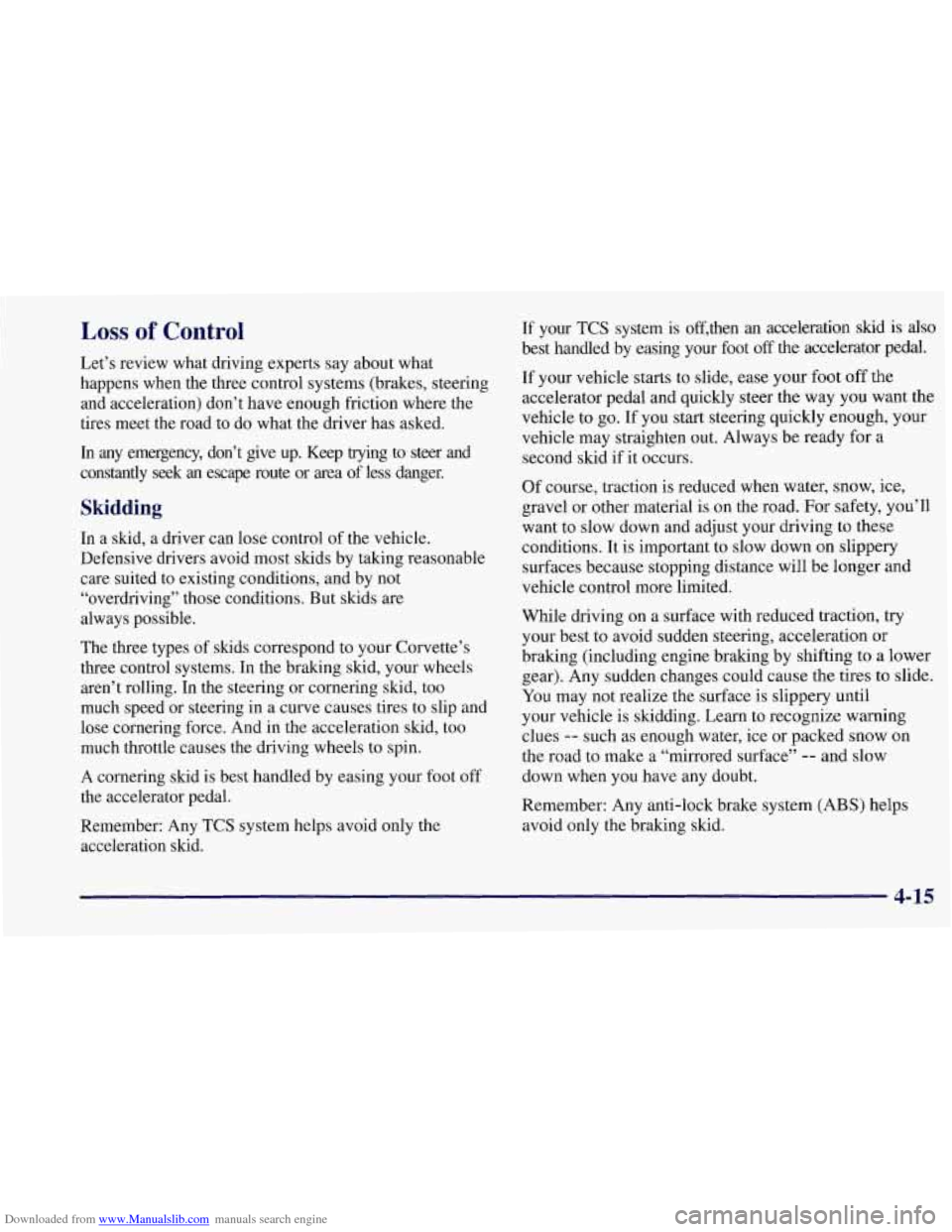
Downloaded from www.Manualslib.com manuals search engine Loss of Control
Let’s review what driving experts say about what
happens when the three control systems (brakes, steering
and acceleration) don’t have enough friction where the
tires meet the road to do what the driver has asked.
In any emergency, don’t give up. Keep trying to steer and
constantly seek an escape route or area of less danger.
Skidding
In a skid, a driver can lose control of the vehicle.
Defensive drivers avoid most skids by taking reasonable
care suited to existing conditions, and by not
“overdriving” those conditions. But skids are
always possible.
The three types of skids correspond to your Corvette’s
three control systems. In the braking skid, your wheels
aren’t rolling. In the steering or cornering skid, too
much speed or steering in a curve causes tires to slip and
lose cornering force. And
in the acceleration skid, too
much throttle causes the driving wheels to spin.
A cornering skid is best handled by easing your foot
off
the accelerator pedal.
Remember: Any TCS system helps avoid only the
acceleration shd.
If your TCS system is off,then an acceleration skid is also
best handled by easing your foot off the accelerator pedal.
If your vehicle starts to slide, ease your foot
off the
accelerator pedal and quickly steer the way you want the
vehicle to go. If you start steering quickly enough, your
vehicle may straighten out. Always be ready for a
second skid if it occurs.
Of course, traction is reduced when water, snow, ice,
gravel
or other material is on the road. For safety, you’ll
want to slow down and adjust your driving to these
conditions. It
is important to slow down on slippery
surfaces because stopping distance will
be longer and
vehicle control more limited.
While driving on a surface with reduced traction, try
your best to avoid sudden steering, acceleration or
braking (including engine braking by shifting to a lower
gear). Any sudden changes could cause the tires to slide.
You may not realize the surface is slippery until
your vehicle is skidding. Learn to recognize warning
clues
-- such as enough water, ice or packed snow on
the road to make a “mirrored surface”
-- and slow
down when you have any doubt.
Remember: Any anti-lock brake system
(ABS) helps
avoid only the bralung skid.
4-15
Page 206 of 356
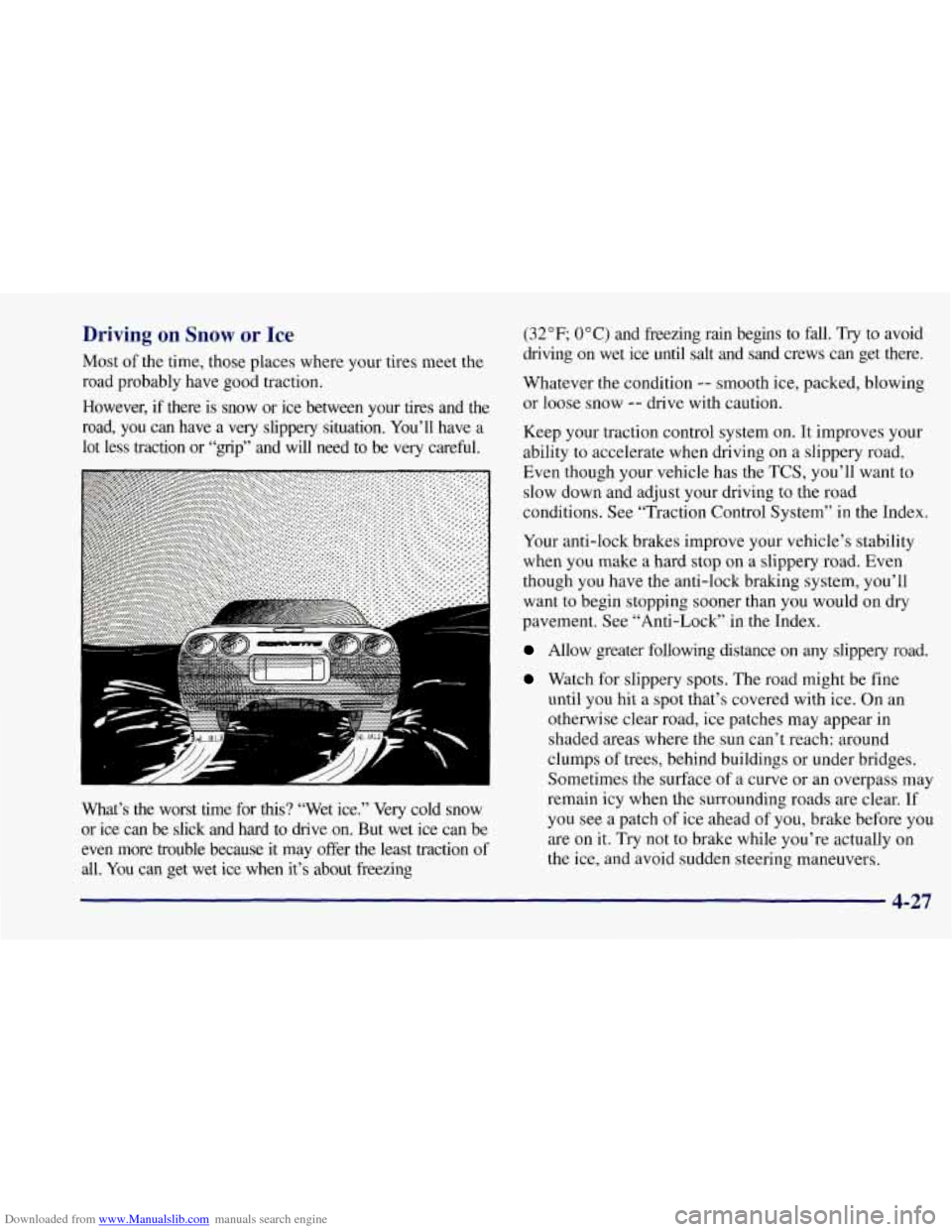
Downloaded from www.Manualslib.com manuals search engine Driving on Snow or Ice
Most of the time, those places where your tires meet the
road probably have good traction.
However, if there is snow or ice between your tires and the
road, you can have a very slippery situation. You’ll have a
lot less traction or “grip” and will need to be very ca\
reful.
What’s the worst time for
this? “Wet ice.” Very cold snow
or ice can be slick and hard to drive on. But wet ice can be
even more trouble because it may offer the least traction
of
all. You can get wet ice when it’s about freezing (32
OF; 0 O C) and freezing rain begins to fall. Try
to avoid
driving on wet ice until salt and sand crews can get there.
Whatever the condition
-- smooth ice, packed, blowing
or loose snow
-- drive with caution.
Keep your traction control system
on. It improves your
ability to accelerate when driving on a slippery road.
Even though your vehicle has the TCS, you’ll want to
slow down and adjust your driving
to the road
conditions. See “Traction Control System” in the Index.
Your anti-lock brakes improve your vehicle’s stability
when you make
a hard stop on a slippery road. Even
though you have the anti-lock braking system, you’ll
want to begin stopping sooner than you would on dry
pavement. See “Anti-Lock’’ in the Index.
Allow greater following distance on any slippery road.
Watch for slippery spots. The road might be fine
until you hit a spot that’s covered with ice. On an
otherwise clear road, ice patches may appear
in
shaded areas where the sun can’t reach: around
clumps
of trees, behind buildings or under bridges.
Sometimes the surface of a curve or an overpass may
remain icy when the surrounding roads are clear.
If
you see a patch of ice ahead of you, brake before you
are on it. Try not to brake while you’re actually on
the ice, and avoid sudden steering maneuvers.
Page 234 of 356
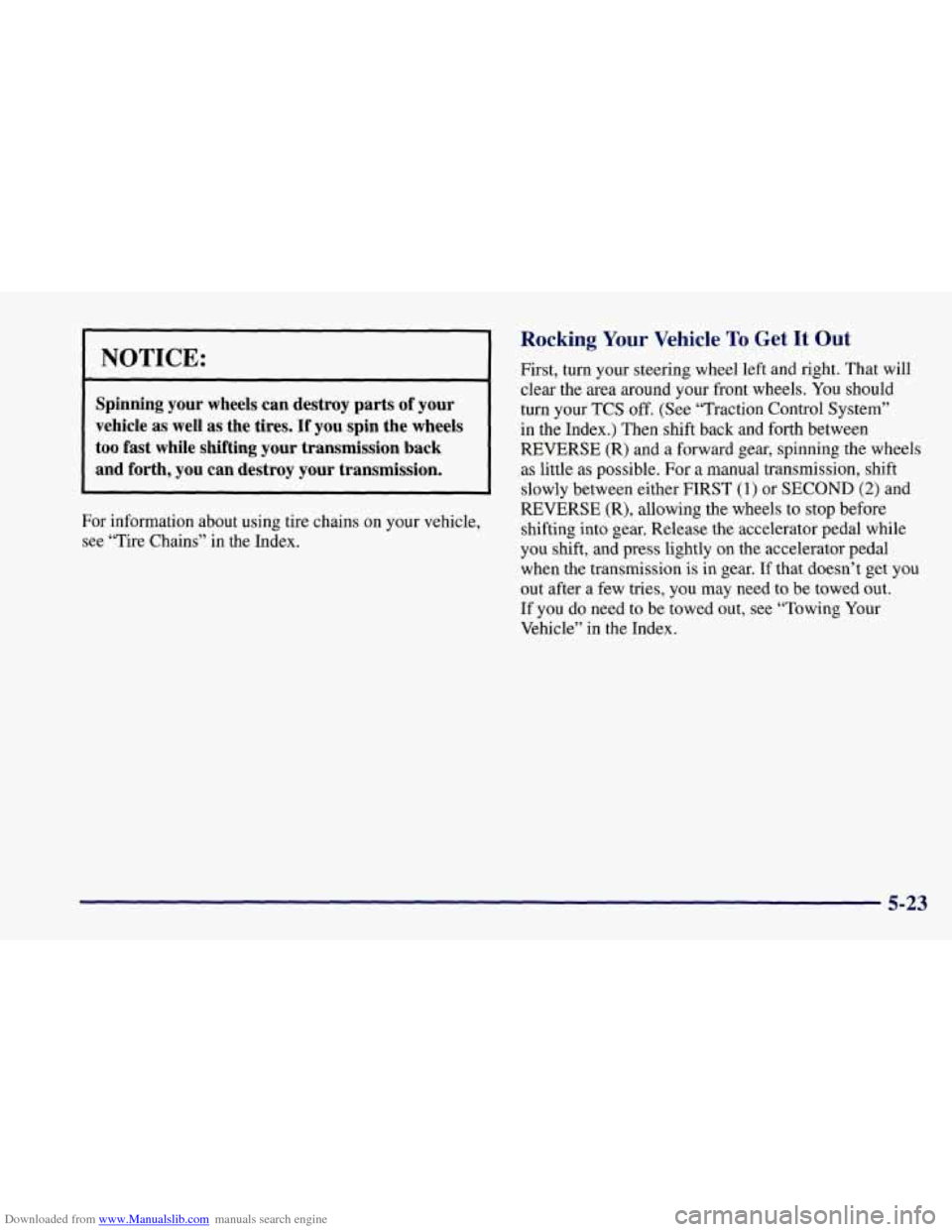
Downloaded from www.Manualslib.com manuals search engine NOTICE:
Spinning your wheels can destroy parts of your
vehicle
as well as the tires. If you spin the wheels
too fast while shifting your transmission back
and forth, you can destroy your transmission.
For information about using tire chains on your vehicle,
see “Tire Chains” in the Index.
Rocking Your Vehicle To Get It Out
First, turn your steering wheel left and right. That will
clear the area around your front wheels. You should
turn your TCS
off. (See “Traction Control System”
in the Index.) Then shift back and forth between
REVERSE (R) and a forward gear, spinning the wheels
as little as possible. For a manual transmission, shift
slowly between either FIRST
(1) or SECOND (2) and
REVERSE (R), allowing the wheels to stop before
shifting into gear. Release the accelerator pedal while
you shift, and press lightly
on the accelerator pedal
when the transmission is in gear.
If that doesn’t get you
out after a few tries, you may need to be towed out.
If you do need to be towed out, see “Towing Your
Vehicle”
in the Index.
5-23
Page 281 of 356
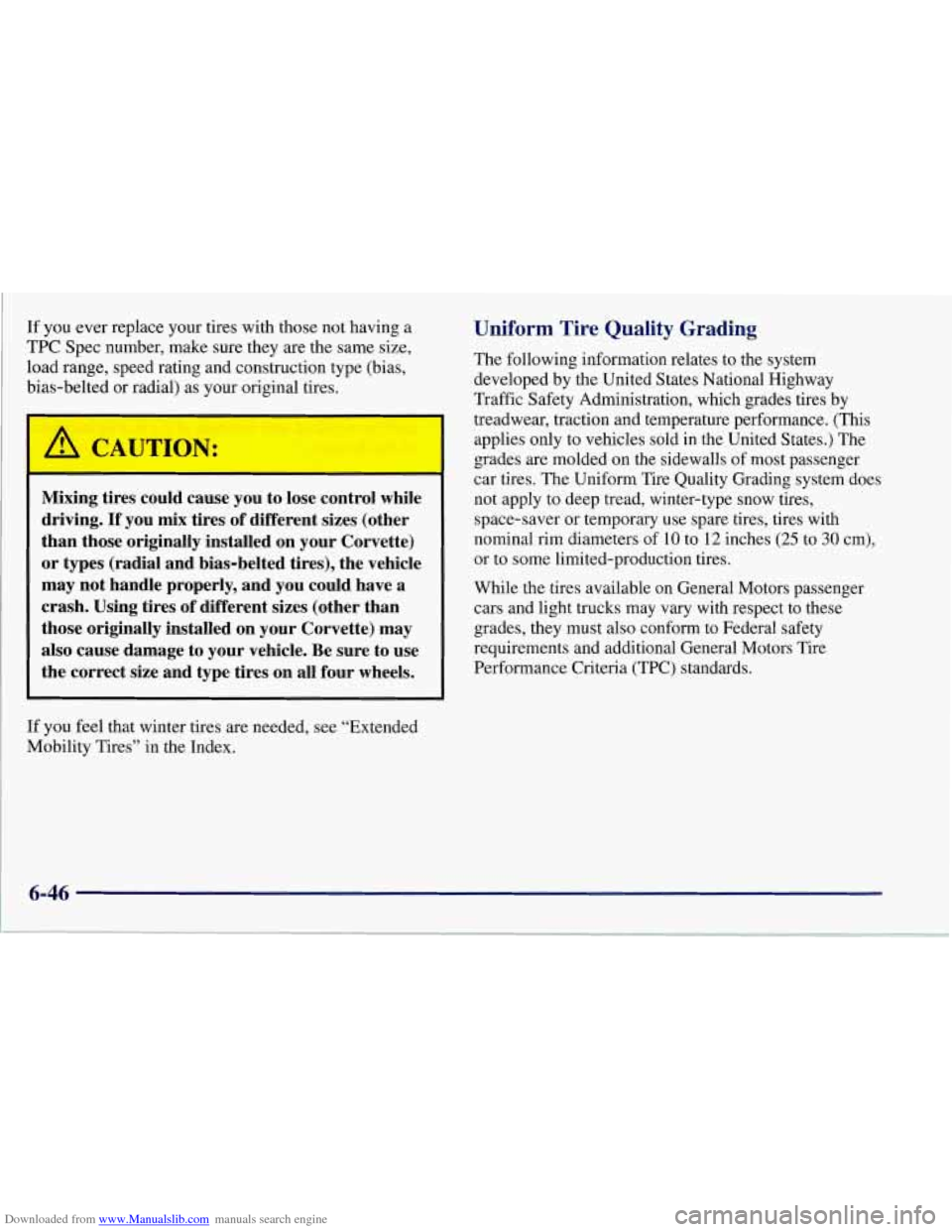
Downloaded from www.Manualslib.com manuals search engine If you ever replace your tires with those not having a
TPC Spec number, make sure they are the same size,
load range, speed rating and construction type (bias,
bias-belted or radial) as your original tires.
I CAJTION:
Mixing tires could cause you to lose control while
driving.
If you mix tires of different sizes (other
than those originally installed on your Corvette)
or types (radial and bias-belted tires), the vehicle
may not handle properly, and you could have a
crash. Using tires of different sizes (other than
those originally installed on your Corvette) may
also cause damage to your vehicle. Be sure to use
the correct size and type tires on all four wheels.
Uniform Tire Quality Grading
The following information relates to the system
developed by the United States National Highway
Traffic Safety Administration, which grades tires by
treadwear, traction and temperature performance. (This
applies only to vehicles sold in the United States.) The
grades are molded on the sidewalls of most passenger
car tires. The Uniform Tire Quality Grading system does
not apply to deep tread, winter-type snow tires,
space-saver or temporary use spare tires, tires with
nominal rim diameters
of 10 to 12 inches (25 to 30 cm),
or to some limited-production tires.
While the tires available on General Motors passenger
cars and light trucks may vary with respect to these
grades, they must also conform to Federal safety
requirements and additional General Motors Tire
Performance Criteria
(TPC) standards.
If
you feel that winter tires are needed, see “Extended
Mobility Tires” in the Index.
Page 282 of 356
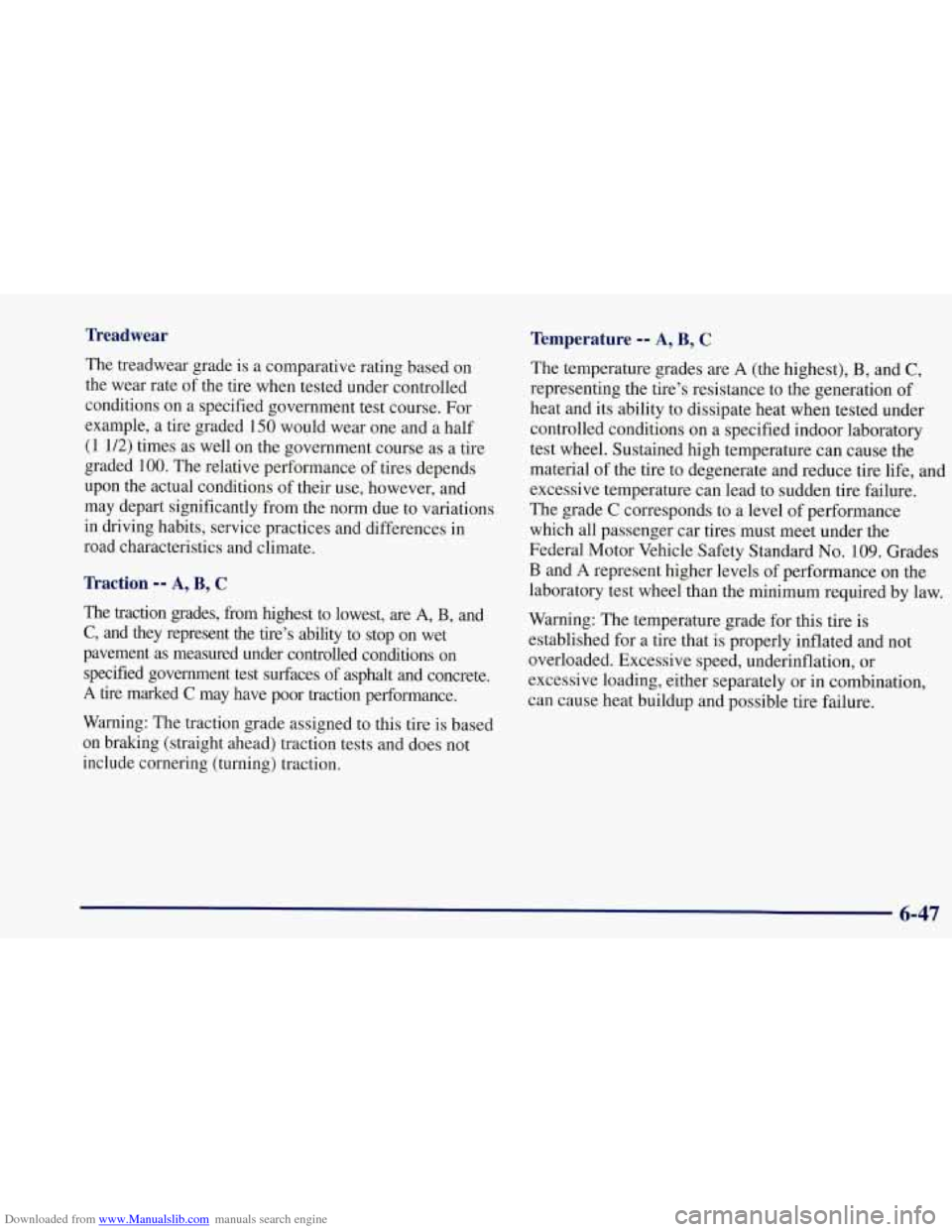
Downloaded from www.Manualslib.com manuals search engine Treadwear Temperature -- A, B, C
The treadwear grade is a comparative rating based on
the wear rate of the tire when tested under controlled
conditions on a specified government test course. For
example, a tire graded
150 would wear one and a half
(1 1/2) times as well on the government course as a tire
graded
100. The relative performance of tires depends
upon the actual conditions of their use, however, and
may depart significantly from the norm due to variations
in driving habits, service practices and differences
in
road characteristics and climate.
Tkaction -- A, B, C
The traction grades, from highest to lowest, are A, B, and
C, and they represent the tire’s ability to stop on wet
pavement as measured under controlled conditions on specified government test surfaces of asphalt and concrete.
A tire marked C may have poor traction performance.
Warning: The traction grade assigned to this tire is based
on bralung (straight ahead) traction tests and does not
include cornering (turning) traction. The
temperature grades are
A (the highest), B, and C,
representing the tire’s resistance to the generation of
heat and its ability to dissipate heat when tested under
controlled conditions on a specified indoor laboratory
test wheel. Sustained high temperature can cause the
material of the tire to degenerate and reduce tire life, and
excessive temperature can lead to sudden tire failure.
The grade
C corresponds to a level of performance
which all passenger car tires must meet under the
Federal Motor Vehicle Safety Standard
No. 109. Grades
B and A represent higher levels of performance on the
laboratory test wheel than the minimum required by law.
Warning: The temperature grade for this tire is
established for a tire that is properly inflated and not
overloaded. Excessive speed, underinflation, or
excessive loading, either separately or in combination,
can cause heat buildup and possible tire failure.
6-47
Page 347 of 356
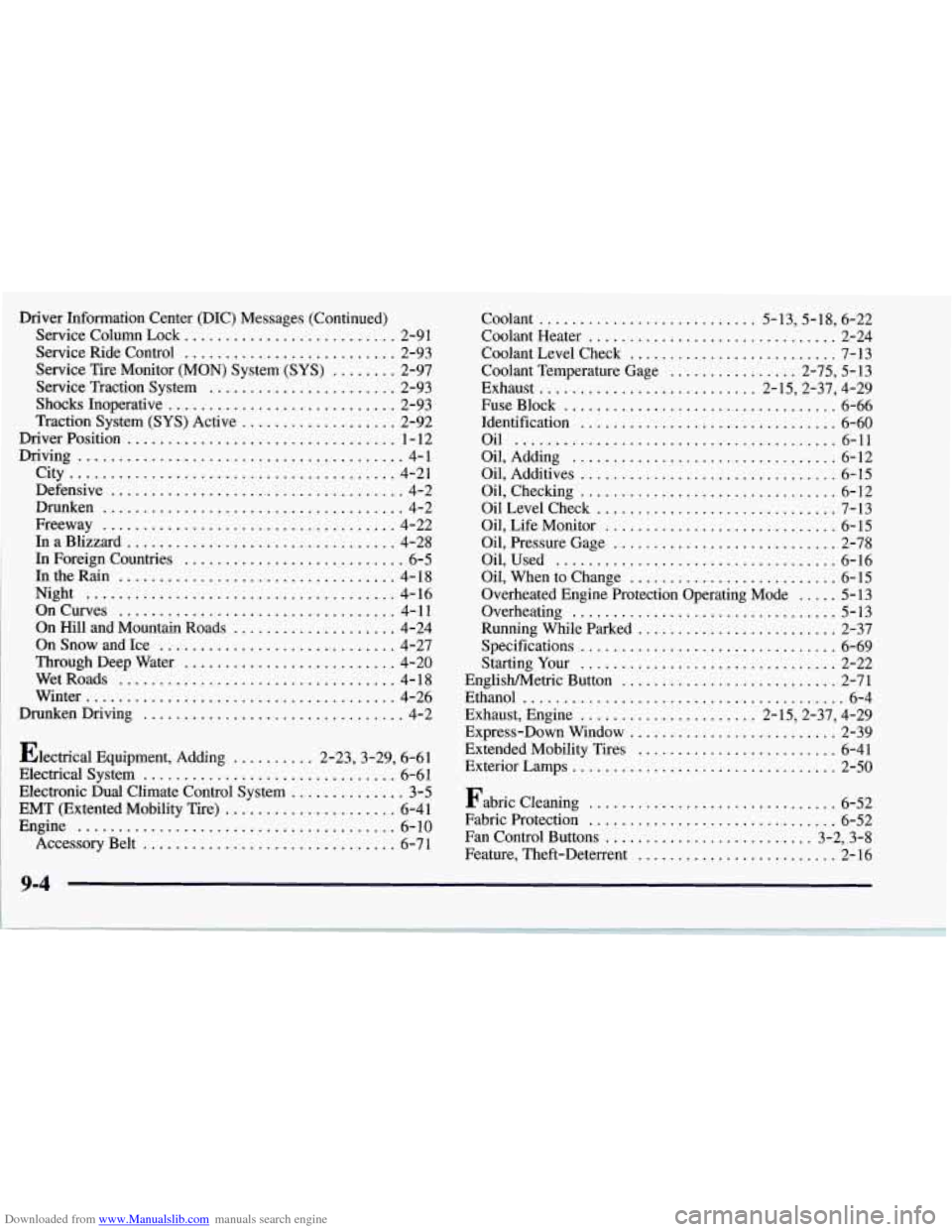
Downloaded from www.Manualslib.com manuals search engine Driver Information Center (DIC) Messages (Continued)
Service Column Lock
.......................... 2-91
Service Ride Control
.......................... 2-93
Service Tire Monitor (MON) System
(SYS) ........ 2-97
Service Traction System
....................... 2-93
Shocks Inoperative
............................ 2-93
Traction System
(SYS) Active ................... 2-92
Driving
........................................ 4-1
DriverPosition
................................. 1-12
City
........................................ 4-21
Defensive
.................................... 4-2
Drunken
..................................... 4-2
Freeway
.................................... 4-22
InaBlizzard
................................. 4-28
In Foreign Countries
........................... 6-5
In the Rain
.................................. 4- 18
Night
...................................... 4-16
OnCurves .................................. 4-11
On Hill and Mountain Roads .................... 4-24
On Snow and Ice
............................. 4-27
Through Deep Water
.......................... 4-20
WetRoads
.................................. 4-18
Winter
...................................... 4-26
Drunken Driving
................................ 4-2
Electrical Equipment. Adding
.......... 2-23,3-29, 6-61
Electrical System
............................... 6-61
Electronic Dual Climate
Control System .............. 3-5
EMT (Extented Mobility Tire)
..................... 6-41
Engine
....................................... 6-10
AccessoryBelt
............................... 6-71 Coolant
........................... 5.13.5.18. 6.22
Coolant Heater
............................... 2-24
Coolant Level Check
.......................... 7-13
Coolant Temperature Gage
................ 2.75. 5. 13
Exhaust
........................... 2.15.2.37. 4.29
FuseBlock
.................................. 6-66
Identification
................................ 6-60
Oil
........................................ 6-11
Oil, Adding
................................. 6-12
Oil, Additives
................................ 6-15
Oil. Checking
................................ 6-12
OilLevelCheck .............................. 7-13
Oil, Life Monitor
............................. 6-15
Oil, Pressure Gage
............................ 2-78
Oil, Used
................................... 6-16
Oil, When to Change
.......................... 6-15
Overheated Engine Protection Operating Mode
..... 5-13
Overheating
................................. 5-13
Running While Parked
......................... 2-37
Specifications
................................ 6-69
StartingYour
................................ 2-22
EnglishMetric Button
........................... 2-71
Ethanol
........................................ 6-4
Exhaust, Engine
...................... 2-15,2-37, 4-29
Express-Down Window
.......................... 2-39
Extended Mobility Tires
......................... 6-41
Exterior Lamps
................................. 2-50
Fabric Protection
............................... 6-52
Fan Control Buttons
.......................... 3-2, 3-8
Feature, Theft-Deterrent ......................... 2-16
Fabric
Cleaning
............................... 6-52
Page 349 of 356

Downloaded from www.Manualslib.com manuals search engine Inspections .................................... 7-17
Brakesystem
................................ 7-17
Exhaust System
.............................. 7-17
Radiator and Heater Hose
...................... 7-17
Steering
.................................... 7-17
Suspension
.................................. 7-17
Tire
........................................ 7-17
Wheel
...................................... 7-17
InstrumentPanel
............................... 2-68
Brightness Control
............................ 2-52
Cleaning
.................................... 6-53
Cluster
..................................... 2-7 0
FuseBlock .................................. 6-63
Instrument Panel Cupholder
....................... 2-54
Interior Lamps
................................. 2-52
Jump Starting
.................................. 5-3
Key Fob Transmitter
............................ 2-6
Key Lock Cylinders Service
...................... 7-14
Labels
....................................... 4-30
Keys
.......................................... 2-2
Certification
................................. 4-30
Service Parts Identification
..................... 6-60
Tire-Loading Information
...................... 4-30
Vehicle Identification Number
................... 6-60
Cleaning Exterior LampsLenses
................. 6-56
Courtesy
.................................... 2-52
Exterior
.................................... 2-50
Interior
..................................... 2-52
OnReminder
................................ 2-44
Lamps Latches.
Seatback
................................ 1-5
Leaving Your Vehicle
............................. 2-5
Leaving Your Vehicle with the Engine Running
....... 2-34
Lighter
....................................... 2-57
Lights Air Bag Readiness
....................... 1-20, 2-72
Anti-Lock Brake System Warning
............ 2-74, 4-7
Brake System Warning
......................... 2-73
Check Engine
................................ 2-76
Safety Belt Reminder
...................... 1-7, 2-72
Traction Control System
(TCS) .................. 2-75
Loading Your Vehicle
........................... 4-30
CheckGages
................................ 2-79
Security
.................................... 2-79
Locks
......................................... 2-4
Cylinders
................................... 7-14
Door
........................................ 2-4
Ignition Transmission Lock Check
............... 7-16
Key Lock Cylinders Service
.................... 7-14
PowerDoor
.................................. 2-5
Using the Wheel Lock Key
..................... 6-50
Lubricants and Fluids
............................ 7-18
Lubrication Service, Body
........................ 7-14
Maintenance Record
........................... 7-20
Maintenance Schedule
............................ 7-1
Periodic Maintenance Inspections
................ 7-17
Recommended Fluids and Lubricants
............. 7-18
Scheduled Maintenance Services
.................. 7-4
Your Vehicle and the Environment
................ 7-2
Maintenance, Underbody
......................... 6-57
Malfunction Indicator Lamp
...................... 2-76
Page 353 of 356
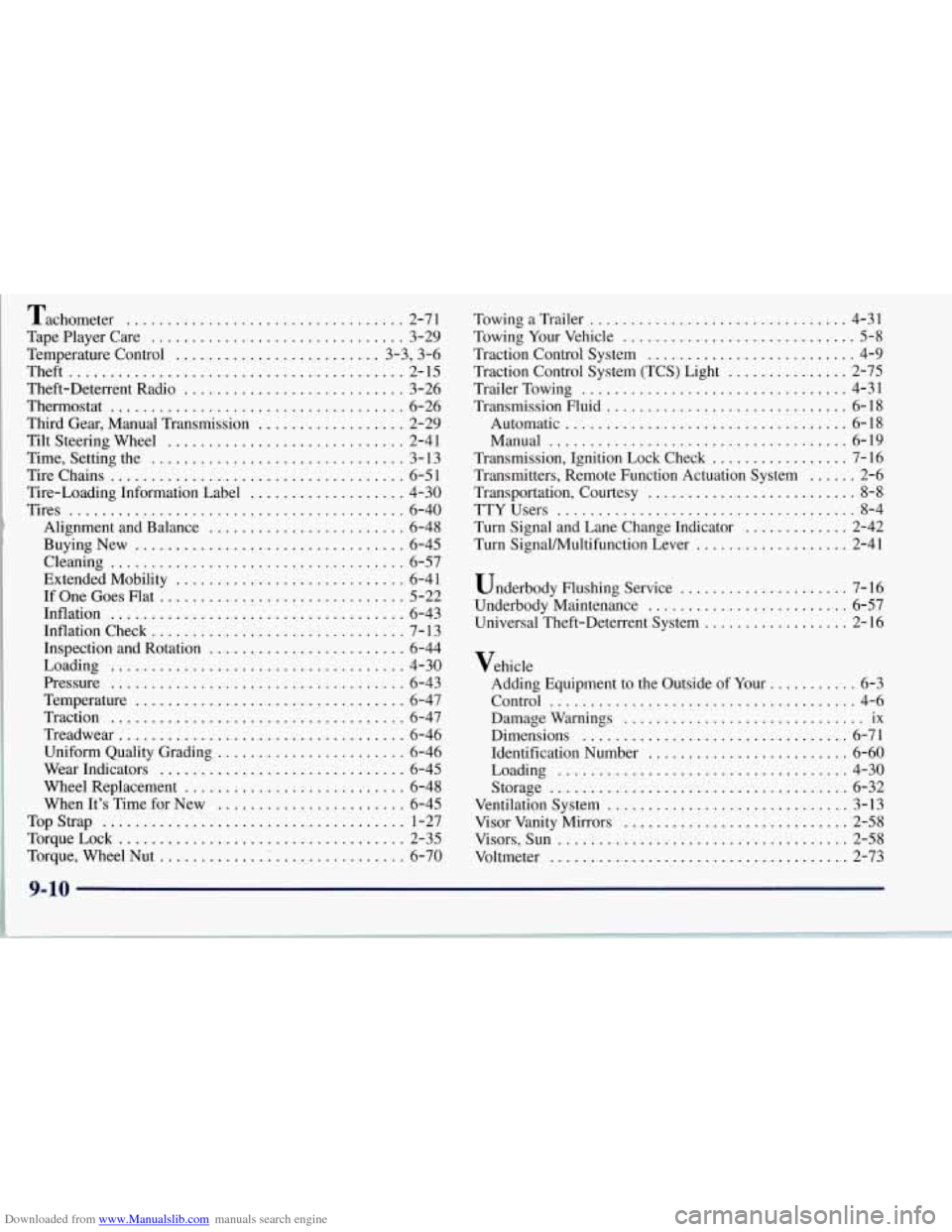
Downloaded from www.Manualslib.com manuals search engine Tachometer .................................. 2-7 I
TapePlayerCare ............................... 3-29
Temperature Control
......................... 3.3. 3.6
Theft
......................................... 2-15
Theft-Deterrent Radio
........................... 3-26
Thermostat
.................................... 6-26
Third Gear. Manual Transmission
.................. 2-29
Tilt Steering Wheel
............................. 2-41
Time. Setting the
............................... 3- 13
Tirechains
.................................... 6-51
Tire-Loading Information Label
................... 4-30
Tires
......................................... 6-40
Alignment and Balance
........................ 6-48
BuyingNew
................................. 6-45
Cleaning
.................................... 6-57
Extended Mobility
............................ 6-41
If One Goes Flat
.............................. 5-22
Inflation
.................................... 6-43
Inflation Check
............................... 7- 13
Inspection and Rotation
........................ 6-44
Loading
.................................... 4-30
Pressure
.................................... 6-43
Temperature
................................. 6-47
Traction
.................................... 6-47
Treadwe
ar ................................... 6-46
Uniform Quality Grading
....................... 6-46
Wear Indicators
.............................. 6-45
Wheel Replacement
........................... 6-48
When It’s Time for New
....................... 6-45
TopStrap
..................................... 1-27
TorqueLock
................................... 2-35
Torque, Wheel Nut
............. ................ 6-70 TowingaTrailer
................................ 4-31
Traction Control System
.......................... 4-9
Traction Control System (TCS) Light
............... 2-75
Towing
Your Vehicle
............................. 5-8
TrailerTowing ................................. 4-31
Transmission Fluid
.............................. 6-18
Automatic
................................... 6-18
Manual
..................................... 6-19
Transmission. Ignition Lock Check
................. 7-16
Transportation. Courtesy
.......................... 8-8
TTYUsers ..................................... 8-4
Turn Signal and Lane Change Indicator
............. 2-42
Turn SignalMultifunction Lever
................... 2-41
Underbody Flushing Service
..................... 7-16
Underbody Maintenance
......................... 6-57
Transmitters. Remote Function Actuation System
...... 2-6
Universal Theft-Deterrent System
.................. 2-16
Vehicle Adding Equipment to the Outside
of Your ........... 6-3
Control
...................................... 4-6
Damage Warnings
.............................. ix
Dimensions ................................. 6-71
Identification Number
......................... 6-60
Loading
.................................... 4-30
Ventilation System
.............................. 3-13
Visor Vanity Mirrors
............................ 2-58
Visors. Sun
.................................... 2-58
Voltmeter
..................................... 2-73
Storage
..................................... 6-32
9-10